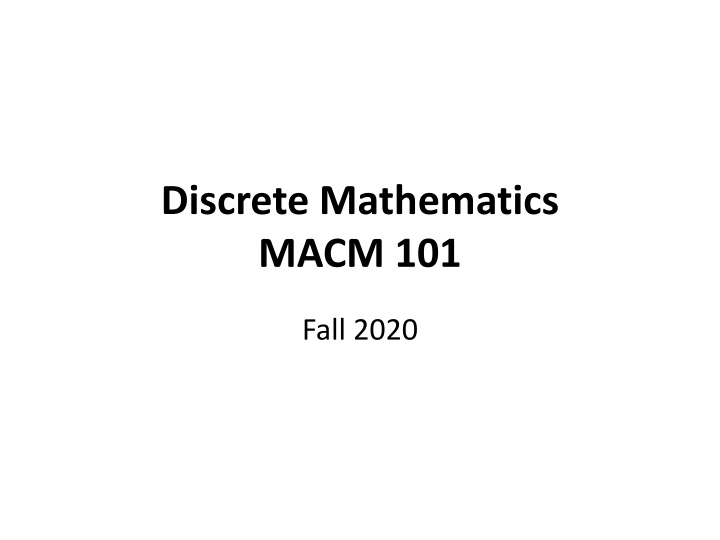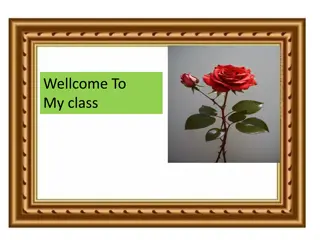
Discrete Mathematics MACM 101 Fall 2020 Course Information
Get all the essential information about the Discrete Mathematics MACM 101 course for Fall 2020, including course instructors, meeting times, web page details, required textbooks, and interactive activities. Stay updated on lectures, tutorials, and assignments to ace the course!
Download Presentation

Please find below an Image/Link to download the presentation.
The content on the website is provided AS IS for your information and personal use only. It may not be sold, licensed, or shared on other websites without obtaining consent from the author. If you encounter any issues during the download, it is possible that the publisher has removed the file from their server.
You are allowed to download the files provided on this website for personal or commercial use, subject to the condition that they are used lawfully. All files are the property of their respective owners.
The content on the website is provided AS IS for your information and personal use only. It may not be sold, licensed, or shared on other websites without obtaining consent from the author.
E N D
Presentation Transcript
Discrete Mathematics MACM 101 Fall 2020
Acknowledgement Used some slides prepared by Prof. Sandy Irani, the author of MACM 101 textbook.
Course Instructors Instructor: Prof. Binay Bhattacharya Teaching Assistants: ? ? ?
Course Meeting Times Lectures: MWF 12:30 1:20 Delivered remotely using Zoom Tutorials (More later once TAs are assigned)
Course Meeting Times Lectures: MWF 12:30 1:20 Delivered remotely using Zoom Tutorials (More later once TAs are assigned) Led by TAs (Remotely) No new materials are presented Question and answer format No tutorials this week.
Course Web Page www.cs.sfu.ca/~binay/2020/macm101 Office hours, contact info Course administration Schedule Topics Reading assignments Homeworks Test schedule All the hand-outs/announcements
Text (zyBook) Web-based, interactive text Subscription for the quarter ($48) zyBooks.com to sign up. zyBook code: SFUMACM101BhattacharyaFall2020 Click Subscribe Required for the course: Data on activities is recorded and counts for a small portion of course credit. You get credit if you eventually get the question correct.
Text (zyBook) Two types of interactive activities: Participation activities (labeled with P ) Due at the time the reading is due (generally before the class) Shorter and easier Reinforce/teach concepts
Text (zyBook) Two types of interactive activities (contd): Challenging activities (labeled with C ) Due at the time the homework is due. More challenging. Test mastery. Will be explicitly listed in homework assignment.
Text (zyBook) Student activities automatically time stamped Your progress visible on your dashboard. Sep 11 and 14 reading is due Monday, Sep 14 at 12 noon. After the first two weeks, most often, the reading for each lecture is due 12 noon on the day of the lecture.
Text (zyBook) Provide feedback: Technical issues with your subscription: support@zyBooks.com Small bugs in the test Feedback buttons in the text support@zyBooks.com Technical problems that prevent understanding the material support@zyBooks.com cc me: binay@cs.sfu.ca
Schedule 1
Homework Homework consists of two parts: Electronic: challenge activities in your zyBook Written: exercises handed out Both parts are due at 12:15PM No late homework is accepted Solutions will be made visible in text after due date.
Coursys You will hand in written homework through Coursys system (as it stands now). You will be notified if there is a change. Coursys can be found at https://coursys.sfu.ca/ Everyone enrolled in the class has been added and has an account. You need to upload a pdf file with your written homework to Coursys for grading. Coursys will maintain all your scores in various activities.
Course Grades Homework: 15% Reading: 5% 4 Tests: 40% Final exam: 40%
Tests Each test has two parts: One electronic part and the other written part. The written part exam will be taken in the form of take-home exam. More details later. All tests are mandatory.
Questions on Grading After each test or HW score is posted, the questions on grading should first go to the person who graded it. By e-mail. Talk to me about the unresolved grading questions.
Lecture slides All lecture slides will be posted on the course webpage (www.cs.sfu.ca/~binay/2020/macm101) After each lecture, I will post the contents of the slides generated from the lecture. Posted slides are not a complete record of what happened in the class. You are responsible for whatever is said in the lecture.
Canvas (https://canvas.sfu.ca/) Online forum All questions related to course content should be posted on Canvas (not asked by email) Instructors can add their own solution. The TAs and I will check Canvas at least once a day.
Questions The best way to get questions answered: Discussion section of Canvas My office hours (Remote) TA office hours (Remote)
Office Hours Highly under-utilized resource Office hours are not study hall . How these interactions get evolved is anybody s guess. We will improvise as we go.
Academic Honesty It is important, specially in this remote setting. Read the school policy. Write up your homework solutions on your own. If needed, I will meet students one on one to check the authenticity of the answers.
What is discrete mathematics? Discrete mathematics is the mathematics of computing
What is MACM 101 about? Continuous Math vs Discrete Math Discrete mathematics is the mathematics of computing Why is it computer science? Mathematical techniques for Discrete Math
Continuous vs Discrete Continuous Mathematics Objects vary continuously Example: analog wristwatch: from analog perspective, between 10:30 am to 10:31 am there are infinitely many possible times Differential equations Sine, cosine functions
Continuous vs Discrete Discrete Mathematics Objects vary in a discrete way Example: digital wristwatch: from analog perspective, between 10:30 am to 10:31 am there are infinitely finitely many possible times. A digital watch does not show split seconds. Integers --- core of discrete mathematics Computer science computers are discrete.
What is MACM 101 about? Why is it computer science?
Number Theory: RSA and Public-key Cryptography Alice and Bob have never met but they would like to exchange a message. Eve would like to eavesdrop. E.g. between you and the Bank of Montreal. They could come up with a good encryption algorithm and exchange the encryption key but how to do it without Eve getting it? (If Eve gets it, all security is lost.) CS folks found the solution: public key encryption. Quite remarkable that is feasible.
Automated Proofs: EQP - Robbin s Algebras are all Boolean A mathematical conjecture (Robbins conjecture) unsolved for decades. First non-trivial mathematical theorem proved automatically. The Robbins problem was to determine whether one particular set of rules is powerful enough to capture all of the laws of Boolean algebra. One way to state the Robbins problem in mathematical terms is: Can the equation not(not(P))=P be derived from the following three equations? [1] P or Q = Q or P, [2] (P or Q) or R = P or (Q or R), [3] not(not(P or Q) or not(P or not(Q))) = P. [An Argonne lab program] has come up with a major mathematical proof that would have been called creative if a human had thought of it. New York Times, December, 1996
Coloring a Map How to color this map so that no two adjacent regions have the same color?
Graph representation Coloring the nodes of the graph: What s the minimum number of colors such that any two nodes connected by an edge have different colors?
Probability and Chances Importance of concepts from probability is rapidly increasing in CS: Randomized algorithms primality testing; Google s PageRank, just a random walk on the web!) in computation, having a few random bits really helps! Machine Learning / Data Mining: find statistical regularities in large amounts of data. Natural language understanding dealing with the ambiguity of language
Goals of MACM 101 Introduce students to a range of mathematical tools from discrete mathematics that are key in computer science. How to write statements correctly. How to read and write theorems. Areas: Counting Logic Set Theory Mathematical Induction Relations Functions Introduction to Graphs
Goals of MACM 101 Introduce students to a range of mathematical tools from discrete mathematics that are key in computer science. How to write statements correctly. How to read and write theorems. Areas: Counting Logic Set Theory Mathematical Induction Relations Functions Introduction to Graphs Note: Learning to do proofs from watching the slides is like trying to learn to play tennis from watching it on TV! So, do exercises!
Acknowledgement Taken some slides from Prof. Bart Selman: www.cs.cornell.edu/courses/cs2800/







